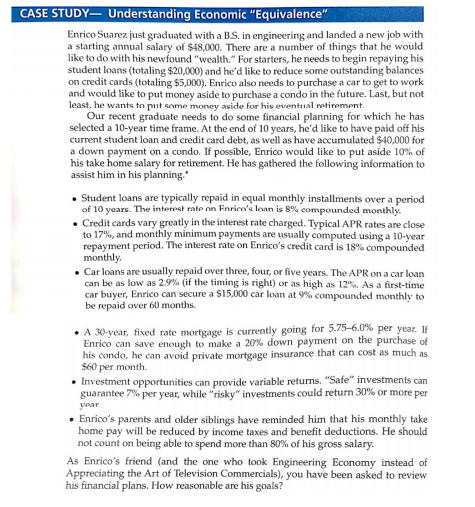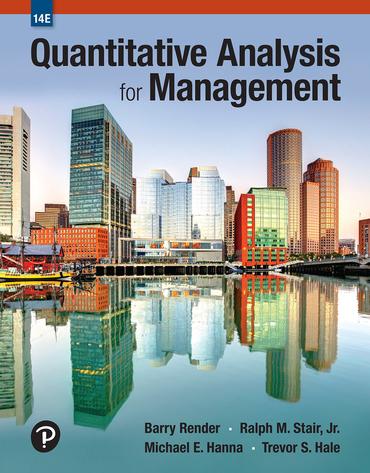
CASE STUDY Understanding Economic "Equivalence" Enrico Suarez just graduated with a B.S. in engineering and landed a new job with a starting annual salary of $48,000. There are a number of things that he would like to do with his newfound "wealth." For starters, he needs to begin repaying his student loans (totaling $20,000) and he'd like to reduce some outstanding balances on credit cards (totaling $5,000). Enrico also needs to purchase a car to get to work and would like to put money aside to purchase a condo in the future. Last, but not least, he wants to put some money aside for his eventual retirement Our recent graduate needs to do some financial planning for which he has selected a 10-year time frame. At the end of 10 years, he'd like to have paid off his current student loan and credit card debt, as well as have accumulated $40,000 for a down payment on a condo. If possible, Enrico would like to put aside 10% of his take home salary for retirement. He has gathered the following information to assist him in his planning." Student loans are typically repaid in equal monthly installments over a period of 10 years. The interest rate nn Enrico's loan is 8% compounded monthly Credit cards vary greatly in the interest rate charged. Typical APR rates are close to 17%, and monthly minimum payments are usually computed using a 10-year repayment period. The interest rate on Enrico's credit card is 18% compounded monthly . Car loans are usually repaid over three, four, or five years. The APR on a car loan can be as low as 2.9% (if the timing is right) or as high as 12%. As a first-time car buyer, Enrico can secure a $15,000 car loan at 9% compounded monthly to be repaid over 60 months A 30-year, fixed rate mortgage is currently going for 5.75-6.0% per year. If Enrico can save enough to make a 20% down payment on the purchase of his condo, he can avoid private mortgage insurance that can cost as much as $60 per month Investment opportunities can provide variable returns, "Safe" investments can guarantee 7% per year, while "risky" investments could return 30% or more per year Enrico's parents and older siblings have reminded him that his monthly take home pay will be reduced by income taxes and benefit deductions. He should not count on being able to spend more than 80% of his gross salary. As Enrico's friend and the one who took Engineering Economy instead of Appreciating the Art of Television Commercials), you have been asked to review his financial plans. How reasonable are his goals? CASE STUDY Understanding Economic "Equivalence" Enrico Suarez just graduated with a B.S. in engineering and landed a new job with a starting annual salary of $48,000. There are a number of things that he would like to do with his newfound "wealth." For starters, he needs to begin repaying his student loans (totaling $20,000) and he'd like to reduce some outstanding balances on credit cards (totaling $5,000). Enrico also needs to purchase a car to get to work and would like to put money aside to purchase a condo in the future. Last, but not least, he wants to put some money aside for his eventual retirement Our recent graduate needs to do some financial planning for which he has selected a 10-year time frame. At the end of 10 years, he'd like to have paid off his current student loan and credit card debt, as well as have accumulated $40,000 for a down payment on a condo. If possible, Enrico would like to put aside 10% of his take home salary for retirement. He has gathered the following information to assist him in his planning." Student loans are typically repaid in equal monthly installments over a period of 10 years. The interest rate nn Enrico's loan is 8% compounded monthly Credit cards vary greatly in the interest rate charged. Typical APR rates are close to 17%, and monthly minimum payments are usually computed using a 10-year repayment period. The interest rate on Enrico's credit card is 18% compounded monthly . Car loans are usually repaid over three, four, or five years. The APR on a car loan can be as low as 2.9% (if the timing is right) or as high as 12%. As a first-time car buyer, Enrico can secure a $15,000 car loan at 9% compounded monthly to be repaid over 60 months A 30-year, fixed rate mortgage is currently going for 5.75-6.0% per year. If Enrico can save enough to make a 20% down payment on the purchase of his condo, he can avoid private mortgage insurance that can cost as much as $60 per month Investment opportunities can provide variable returns, "Safe" investments can guarantee 7% per year, while "risky" investments could return 30% or more per year Enrico's parents and older siblings have reminded him that his monthly take home pay will be reduced by income taxes and benefit deductions. He should not count on being able to spend more than 80% of his gross salary. As Enrico's friend and the one who took Engineering Economy instead of Appreciating the Art of Television Commercials), you have been asked to review his financial plans. How reasonable are his goals







